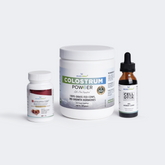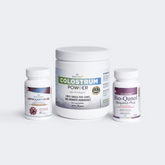The Fat-Soluble Vitamins: Vitamins A, D, E, & K
Estimated Reading Time: 8 minutes
Mic Check! Fit Check! And Among All the Things We Keep in Check, Do We Have Our Vitamins in Check?
In 1912, Polish biochemist Casimir Funk, the father of vitamin therapy, coined the term “vitamins.” He derived it from “vital amines,” believing all vitamins contained an amine group. Vita means life, and “amine” refers to a nitrogen-containing substance essential for life.
As we all know, our bodies require nutrients to sustain and perform their functions. While fats, proteins, and carbohydrates are a must, there comes another important type: micronutrients.
What are Micronutrients?
Micronutrients are vitamins and minerals that the body needs in tiny amounts. Even though they're needed in small quantities, they are essential for staying healthy. A lack of any micronutrients can lead to serious health problems. They help the body make essential things like enzymes, hormones, and other substances needed for proper growth and development.
Keep reading for a quick overview of vitamins, with a focus on fat-soluble ones.
As already mentioned, these are essential vital amines required by the body and work together to perform different functions. Vitamins are further classified based on how they are absorbed in the body.
Traditionally, the classification of Vitamins is as follows:
-
Fat-soluble
-
Water-soluble
Also Read: What Are Lipid-Soluble Vitamins and Why Do You Need Them?
What are water-soluble vitamins?
These include vitamin B and vitamin C. They dissolve in water, get absorbed directly into the bloodstream, and are not stored much in the body. As these are not stored, a regular intake of these water-soluble vitamins is necessary to maintain adequate levels and prevent deficiencies.
What are fat-soluble vitamins?
These include Vitamins A, D, E, and K. These require fat to be absorbed, are stored in the liver and fatty tissues, and can last longer in the body.
Hold On, Let’s Explore the Fat-Soluble Vitamins:
Let’s take a quick look and answer some simple questions:
-
What do they do?
-
From where can they be sourced?
-
How much do we require?
Do you know the answers??
If not, without further ado, dive in & read! Going alphabetically, we have
1. Vitamin A, also known as Retinol
Importance
It is important for vision, helps immune function or natural defense against infection or illness, and keeps the skin and lining of some parts healthy, e.g., the inner layer of the nose.
It helps keep our lungs, heart, and other organs working properly.
Do you know the different forms of Vitamin A?
There are two different forms of vitamin A
-
Retinoids (Retinol, Retinal, Retinoic Acid) – Found in animal sources.
-
Carotenes (Alpha, α; beta, β, and gamma, γ) – Found in plants, beta (β)-carotene is the main pro-vitamin A, which means that it gets converted to vitamin within the body.
Let’s quickly navigate to how Vitamin A gets processed (metabolized) in the body:
It happens in 3 simple steps as given below :
-
Step no. 1 (Conversion)- The body takes plant-based vitamin A (β-carotene) and changes it into its active form (retinol) with the help of special enzymes.
-
Step no. 2 (Transportation)- Retinol is packed with fats and sent to the liver for storage.
-
Step no. 3 (Storage)- The liver stores most of the body's vitamin A. To keep it safe and prevent loss through the kidneys, vitamin A binds to unique proteins (Retinol-Binding Protein & Transthyretin).
In this way, our Vitamin A gets stored and is made available for use when the body demands it. :)
Let’s know some more about it below :
What are the sources of Vitamin A?
-
Non-vegan: Liver, fish oils, dairy, cheese & fortified low-fat spreads
-
Vegan: Carrots, sweet potatoes, spinach & red peppers & fruits like mango and papaya.
Vitamin A-related deficiencies:
-
Xerophthalmia: Trouble seeing in low light, which can lead to blindness if untreated.
-
Respiratory Diseases: Higher risk of illnesses like pneumonia.
-
Infections: Increased chances of measles and diarrhea.
-
Anemia: Reduced oxygen supply to the body due to low red blood cell levels.
Daily recommended dosage of Vitamin A:
-
Men (ages 19-64): 700 micrograms per day
-
Women (ages 19-64): 600 micrograms per day
Overdose Risks:
-
Too much vitamin A (10 times the RDA or more) can cause toxicity, leading to:
-
Hair loss, cracked lips, dry skin.
-
Headaches, bone issues, high blood calcium.
-
Toxicity can happen faster in infants and children.
-
High carotenoid intake (from food) doesn’t cause toxicity but may turn the skin yellow (harmless).

2. Vitamin D
Importance
Vitamin D helps to regulate calcium and phosphate levels in the body, which are essential for healthy bones, teeth, and muscles.
How Vitamin D Gets Processed in the Body?
Vitamin D is made in the skin when UVB (Ultraviolet B radiation) light from the sun breaks down 7-dehydrocholesterol (a building block for cholesterol and an early form of vitamin D3) into vitamin D3 (cholecalciferol). However, food is a good source of Vitamin D. Before coming to that, let’s understand its metabolism.
You might come across some complex terms, but here's an easy breakdown for you to understand:
Vitamin D goes through three key steps to become active and work properly in the body:
-
Step no. 1. The Liver’s Job (i.e., 25-hydroxylation)- The liver begins changing vitamin D into a form the body can use.
-
Step no. 2. Kidneys make it active (i.e., 1 alpha-hydroxylation)-The kidneys then make vitamin D fully active.
-
Step no. 3. Balancing Act (i.e., 24-hydroxylation)- The body controls the amount of active vitamin D to ensure there is not too much.
These steps are carried out by special enzymes (P450 mixed-function oxidases (CYPs)) in the cells, ensuring the right amount of vitamin D is available to support things like bone health and immunity.
What are the sources of Vitamin D?
-
Sunlight: From late March to September, most people can produce enough vitamin D from direct sunlight on the skin.
-
Food Sources: Non-vegan, including fatty fish, liver, and egg yolks, and vegan, including Fatty plant-based milk, mushrooms (exposed to UV light), and fortified cereals.
Vitamin D-related deficiencies:
-
Rickets (in children): Bone deformities due to lack of vitamin D.
-
Osteomalacia (in adults): Bone pain caused by soft and weakened bones.
Daily recommended dosage of Vitamin D:
-
Adults and children over 1 year: 10 micrograms per day.
-
Babies up to 1 year: 8.5–10 micrograms per day.
Overdose Risks
Taking too much vitamin D for a long time can lead to too much calcium in your body. This causes calcium buildup in the body (called hypercalcemia) and can lead to :
-
Bone Problems
-
Kidney Damage
-
Heart Issues

3. Vitamin E
Importance
Vitamin E comes in different forms, including alpha-, beta-, gamma-, and delta-tocopherols and tocotrienols. It mainly acts as an antioxidant, protecting cells from damage by reactive molecules, along with other forms like tocotrienols.
Vitamin E helps maintain healthy skin and eyes and strengthens the immune system, which is the body’s natural defense against illness and infection.
How is Vitamin E processed in the Body?
Like the above-mentioned fat-soluble vitamins, Vitamin E metabolism also occurs in 3 key steps :
-
Step no. 1. Absorption and Transport: Vitamin E is absorbed with fat in the intestines and enters the bloodstream. It either travels to the liver or lipoproteins carry it to fat tissues, where it is stored.
-
Step 2. Storage: Vitamin E is processed in the liver and then released back into the bloodstream, where it is stored in fat for later use.
-
Step no. 3. Breakdown and Excretion: Enzymes break down Vitamin E, and the body eliminates the waste products through urine or feces.
What are the sources Of Vitamin E?
-
Non-Vegan: Fish, liver, Butter.
-
Vegan: Nuts (almonds, hazelnuts), sunflower seeds, annatto, spinach, wheat germ oil, avocado.
Vitamin E -related deficiencies
-
Red Blood Cells' Fragility: Cells become fragile and break easily.
-
Nerves Damage: Damage to nerves, especially those in the outer parts of the body, leading to weakness and coordination problems.
Other than these, deficiency can also lead to other issues, for instance:
-
In Adults: Weak muscles, Trouble with reflexes and coordination, Difficulty walking
-
In Preterm Infants: It can lead to a serious type of anemia
Daily recommended dosage of Vitamin E:
-
Men: 4 mg per day.
-
Women: 3 mg per day.
Also, read Best Daily Vitamins for Females - Essential Guide
Overdose Risks
Vitamin E overdose is rare but can lead to problems like bleeding, muscle weakness, tiredness, nausea, and diarrhea.
-
The main risk is excessive bleeding.

4. Vitamin K
Importance:
Vitamin K is essential. It helps blood clot and heals wounds, and it supports healthy bones.
Vitamin K comes in two forms:
-
Phylloquinone- Found in plants and absorbed better with fat. It's safe and not toxic.
-
Menaquinone - Made by bacteria in the intestines, but only in small amounts.
How is Vitamin K processed in the Body?
It gets processed in 3 simple steps, like all fat-soluble vitamins :
-
Step no. 1. Absorption: Vitamin K from food is absorbed with fat in the intestines.
-
Step no. 2. Transport: Once absorbed, vitamin K is packed with fat into special particles called chylomicrons (for phylloquinone) or transported by another type of protein like VLDL or LDL (for menaquinones), which carry it to the liver.
-
Step 3. Metabolism and Excretion: Vitamin K is broken down and processed in the liver. It is then excreted from the body through urine or bile.
What are the sources of Vitamin K?
-
Non-Vegan: Presence in tiny amounts in dairy foods & meat
-
Vegan: Green leafy vegetables “spinach & broccoli”, Vegetable oils & cereal grains
Vitamin K-related deficiencies:
-
Vitamin K deficiency can cause hemorrhagic disease in the newborn, characterized by increased bleeding.
-
Osteoporosis (long-term deficiency)
Daily recommended dosage of Vitamin K:
-
Adults need about 1 microgram of vitamin K per kilogram of body weight (0.001 milligram gram) daily. For example, a person weighing 65 kg needs 65 micrograms daily.
Overdose Risk:
-
Natural vitamin K1 is safe to take even in large amounts.
-
However, a synthetic form called menadione can be toxic, especially for infants, causing serious problems.

Conclusion
The fat-soluble Vitamins, i.e., A, D, E & K, are essential micronutrients. These play an utmost important role in keeping overall health. Fat-soluble (stored in liver & fatty tissues) vitamins last longer than water-soluble vitamins, which also means that excessive intake can have harmful effects; therefore, proper dosage is a must.
Lastly, maintaining a healthy diet containing natural food sources along with mindful supplementation is key to maintaining optimal health. Wellness Extract says always to follow recommended daily allowances to keep your vitamins and health in check!
Disclaimer: This content is intended for informational purposes only and has not been reviewed or approved by the Food and Drug Administration. It is not intended to diagnose, treat, cure, or prevent any disease.
References:
-
https://www.nhs.uk/conditions/vitamins-and-minerals/vitamin-a/#:~:text=Vitamin%20A%2C%20also%20known%20as,such%20as%20the%20nose%2C%20healthy
-
https://nutritionandmetabolism.biomedcentral.com/articles/10.1186/s12986-022-00696-y?utm_
-
https://ods.od.nih.gov/factsheets/VitaminA-Consumer/
-
https://www.nhs.uk/conditions/vitamins-and-minerals/vitamin-a/
-
https://www.sciencedirect.com/science/article/pii/S1074552114000246?via%3Dihub
-
https://nutritionandmetabolism.biomedcentral.com/articles/10.1186/s12986-022-00696-y?utm_
-
https://www.msdmanuals.com/home/disorders-of-nutrition/vitamins/vitamin-k-deficiency
































